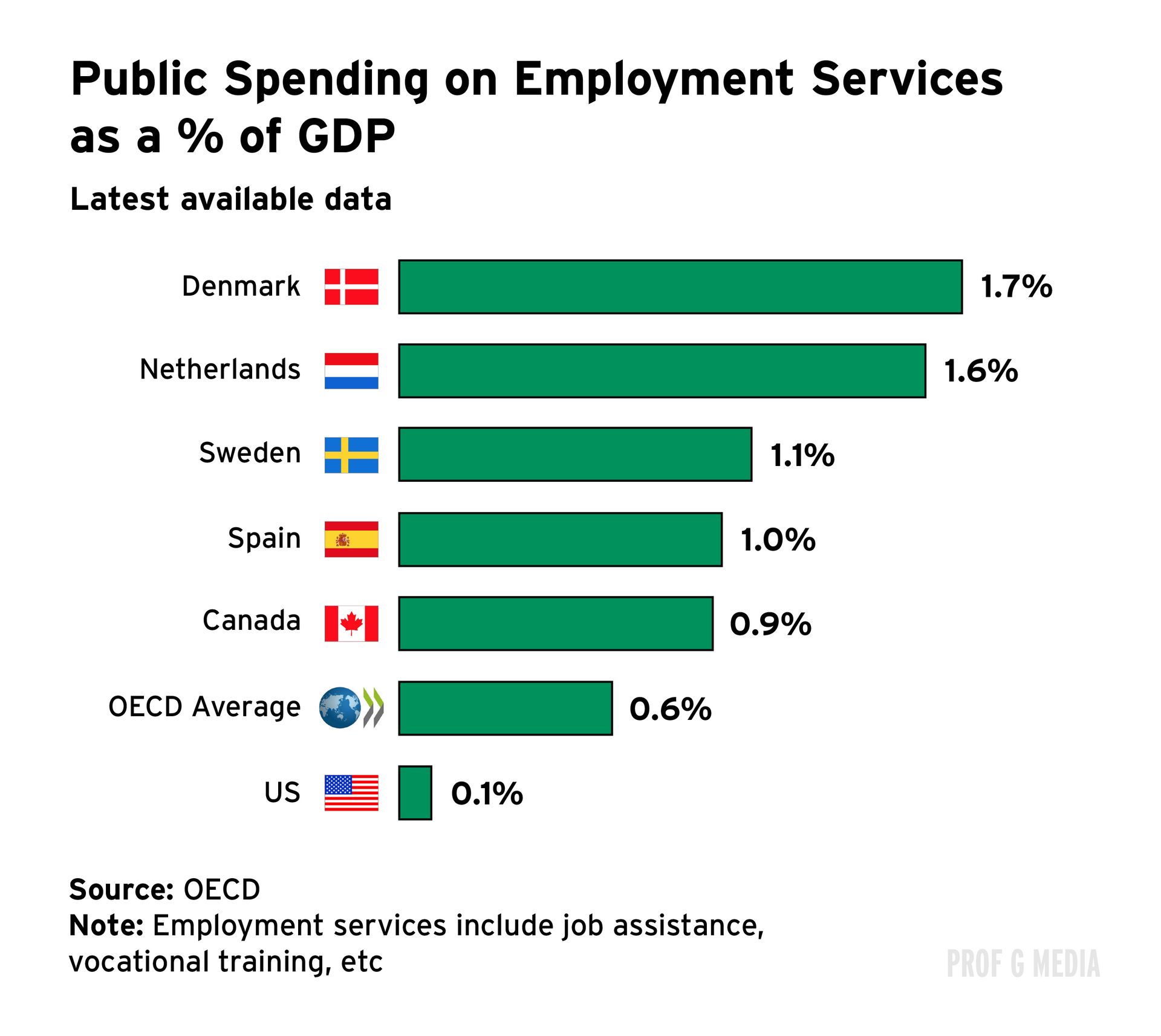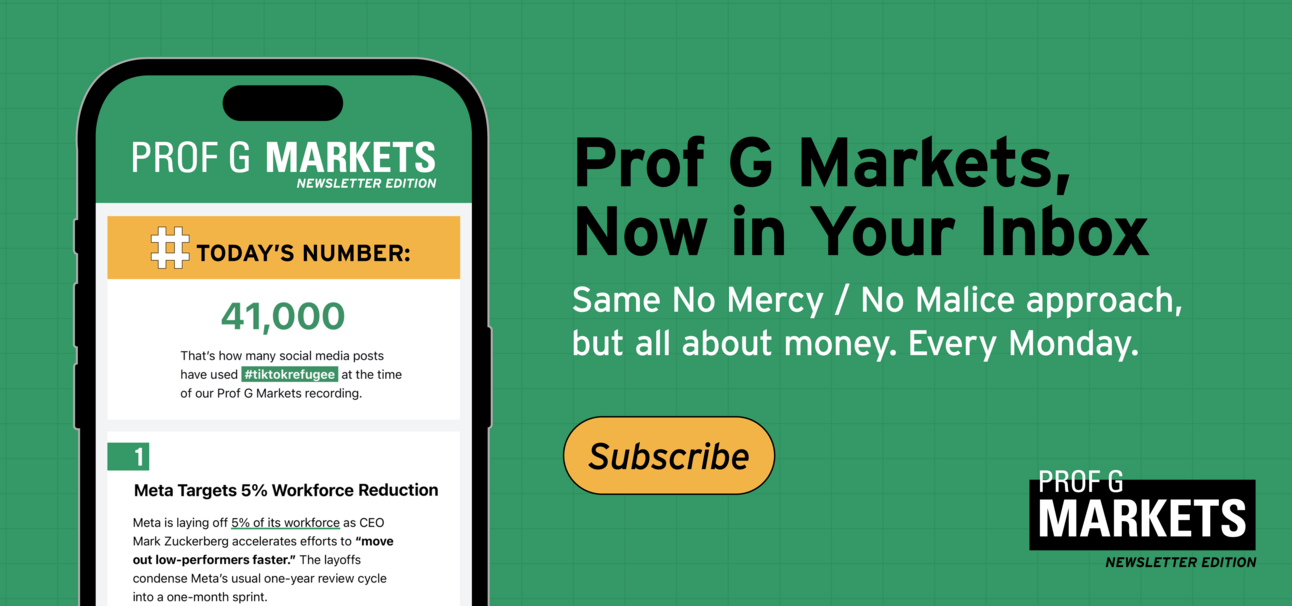In partnership with


50%
Men are three times more likely than women to run the second half of the NYC Marathon at least 50% slower than they ran the first half.

AI comes for middle management
Trump and Xi strike a fragile truce on rare earths
Big Tech earnings review
Newsletter Exclusive: The rise of catastrophe bonds — How investors are profiting from disaster
The AI Job Reckoning: What’s Changing And How To Protect Yourself
For the past year, the leading narrative around AI has been: Don’t worry, ChatGPT won’t take your job. Past innovation cycles suggest that new technologies eventually create more jobs than they destroy — but first they destroy.
Many CEOs have tried to reassure workers that AI will enhance, not replace, their jobs:
“Google has seen a 10% boost in productivity of its engineers thanks to AI … and the company expects to hire more engineers because of it.” - Sundar Pichai
“I think AI augments people; I don’t know if it necessarily replaces them.” - Marc Benioff
“AI destroying jobs and making everyone poor is a ‘fallacy.’” - Marc Andreessen
Yet, the headlines tell a different story. In just the past week, Amazon, Paramount, UPS, YouTube, and Meta all announced new rounds of layoffs. So far this year, U.S. employers have announced 946,000 job cuts, the most since 2020.
AI is coming for middle management first. Amazon’s latest restructuring aims to reduce organizational layers, and the number of managers at public companies dropped 6.1% from May 2022 to May 2025.
The average supervisor now manages six direct reports, double the number five years ago.
The question now isn’t whether AI will take jobs, it’s how you’ll protect yours.
Scott and Ed’s Advice for Anyone Afraid of — or Recovering from — a Layoff
Take inventory of what side of AI you’re on.
Be honest about whether your role falls into a high-risk category. Jobs most exposed to AI disruption include sales and customer service roles, as well as PR, management, and market research analysts.
If you’re in a risky category, get close to decision-makers and take on high-visibility projects. Focus on building new skills and maintaining your professional network now.
Assess where your human capital belongs.
Use a layoff as a chance to reassess where your skills, energy, and values create the most impact. Sometimes being pushed out simply means you weren’t in the right place.
Scott often says his own layoff early in his career was one of the best things that happened to him. He was forced out of Morgan Stanley’s two-year analyst program, which made him stop and ask what he actually wanted to do.
Getting laid off hurts. Staying paralyzed hurts more.
What hurts people most isn’t being laid off, it’s the emotional paralysis that follows. Give yourself a few days to absorb what happened, but don’t get stuck. Go out, meet friends, talk to people. Take care of your mental and physical health and build enough endurance to keep your confidence intact.
Develop skills AI cannot replace.
Focus on judgment, creativity, empathy, leadership, and strategic thinking. Ask your former boss for a coffee, network, and build relationships. These are the traits that endure technological change.
Recognize you may need to develop new skills — or take a pay cut
Successful people are able to experiment, learn quickly, and lean into change — as hard as that can be.
But understand that starting over often means taking a step back first. Seventeen percent of workers who changed employers took a pay cut in 2024, up from 15% in 2023. The ability to detach your self-worth from your salary and focus on long-term growth is a sign of resilience.

Trump’s Trade Truce With China Buys Time, Not Peace
Last week, President Trump and Chinese President Xi Jinping met face-to-face in South Korea. It was their first in-person meeting since Trump’s second term began. The result was a trade truce: China agreed to resume soybean imports and pause its export controls on rare earth elements for a year. In return, Trump cut tariffs on Chinese goods from 57% to 47%.
International relations experts suggest that Xi successfully manipulated Trump’s trade wars to China’s advantage because of the incredible leverage China has over the U.S. economy through rare earths.
The importance of these minerals can't be overstated. Products containing rare earths include: all modern cars, 80% of U.S. weapon systems, most consumer electronics (laptops, cellphones, headphones, TVs), medical equipment like MRI machines, and clean energy tech such as solar panels and wind turbines.
Roughly 15% to 20% of the entire U.S. economy depends on them.
Fortunately, they aren’t rare — just almost completely controlled by China. Rare earth manufacturing is highly pollutive, so Western nations restricted mining in the 1980s, and China filled the gap.
The U.S. is now trying to rebuild supply chain resilience. MP Materials, America's only fully integrated rare earth producer, recently signed a $400 million deal with the Pentagon. American sources could bring capacity high enough to offset imports by 2028.


Trump’s latest trade truce with China is a case study in poor strategic thinking. One of the keys to negotiation is to have an accurate assessment of your leverage and their leverage. This is one of Trump’s many Achilles’ heels: He always thinks he’s playing with a stronger hand than he is. The United States is China’s third-largest trading partner, not the first.
Still, there is a path forward if America can diversify its supply chain. As China developed workarounds after U.S. chip sanctions, the United States could do the same by investing in alternative rare earth sources. The Defense Department is already seeking companies that can reduce reliance on Chinese inputs, and that could prove a strong investment opportunity.
____________sponsored content ____________
Unknown number calling? It’s not random.
The BBC caught scam call center workers on hidden cameras as they laughed at the people they were tricking. One worker bragged about making $250k from victims. The disturbing truth? Scammers don’t pick phone numbers at random. They buy your data from brokers.
Once your data is out there, it’s not just calls. It’s phishing, impersonation, and identity theft. Incogni deletes your info from the web, monitors and follows up automatically, and continues to erase data as new risks appear. Try Incogni here and get 55% off your subscription with code PROFG.
____________sponsored content ____________
Behind Q3 Earnings: Big Tech’s $350B Bet On Infrastructure
Most of the Magnificent Seven reported earnings last week. Overall, it was a strong quarter, with Microsoft, Alphabet, Amazon, and Apple all beating expectations on the top and bottom lines.
Alphabet topped $100 billion in quarterly revenue for the first time ever, driven largely by Google Cloud, which grew 34% year over year (YoY). Shares jumped 7% in after-hours trading.
Amazon posted strong results due to both resilient consumer spending and robust cloud growth, with AWS sales up 20% from a year ago. Shares rose more than 13% after hours.
Microsoft had another strong quarter, with Azure revenue up 39% YoY. But guidance came in line with expectations, disappointing investors given the company’s AI initiatives. Shares fell 4% after hours.
Apple reported record revenue and profit fueled by demand for the new iPhone. Sales in China fell 3.6%, but CEO Tim Cook said he expects growth to rebound. Shares rose over 4% after hours, following a forecast of accelerating iPhone sales and 10–12% revenue growth in the current quarter.
Meta posted 26% revenue growth, but expenses rose faster, compressing operating margin to 40% from 48% last year. CEO Mark Zuckerberg raised guidance for capex substantially, adding Meta is “front-loading capacity to be ready for the most optimistic cases.” Shares dropped more than 7% after hours.
It’s official: Big Tech’s business model is flipping from asset-light to asset-heavy. Apple, Amazon, Alphabet, Microsoft, and Meta are on track to spend over $350 billion in capex this year — roughly $100 billion more than last year.
$100 billion is more than Tesla’s and Disney’s annual revenue last year.
These companies spent the last decade building high-margin, high-free-cash-flow businesses in software, ads, and cloud. Now they’re redeploying those profits into the physical infrastructure of AI.
Today, Meta, Microsoft, and Alphabet each invest a larger share of revenue in capex than the average global utility.

Investors are comfortable with rising capex at Amazon, Microsoft, and Google because it’s funding profitable, high-growth cloud businesses. Meta’s spending, however, drew the harshest reaction this quarter. Its bet on AI is that it will supercharge engagement and advertising — or that Zuckerberg has something else up his sleeve.
The open question is whether Big Tech’s premium valuations — justified by years of asset-light growth — still hold up as they become asset-heavy.

Instagram Reels is now making $50 billion a year. By comparison, the entire US TV ad industry makes $65 billion. So give it a couple years, and Instagram Reels is gonna be bigger than the entire ad industry in the US for television. That’s crazy.

The company that looks overvalued here is Apple, which is growing 8%. That’s not great growth for Big Tech, and yet they have the highest multiple with the exception of Microsoft.
Retail investors don't spend enough time talking about valuation. At some point, any stock is overvalued, and at some point, every stock, unless it's going to zero, is undervalued.
Amazon looks right now to be less expensive than the others when you look at its growth and when you look at historical trading multiples. So I’m bullish on Amazon.
Newsletter Exclusive: The Business of Catastrophe
Nothing says late-stage capitalism like profiting from climate catastrophe.
One of the hottest financial trends you’ve probably never heard of is the catastrophe bond, or CAT bond, a financial instrument that lets investors bet (indirectly) on disasters. These bonds insure against predefined catastrophes — say, earthquakes in California or hurricanes in Florida — offering investors a way to profit from climate change.
How does it work?
A CAT bond lets insurers transfer some of the financial risk of major disasters to investors. Investors who buy the bond receive regular interest payments, just like a traditional bond. If no qualifying disaster occurs during the bond’s term, they get their full principal back at maturity. But if a disaster does occur, the insurer keeps the original investment to cover its losses, and investors don’t get it all back.
CAT bonds are usually issued by insurers as an alternative or complement to traditional reinsurance. But their use has expanded well beyond the insurance industry. The World Bank issues them to help poorer countries that lack robust insurance markets, New York City’s Metropolitan Transportation Authority has issued them to hedge against severe storms, and Google uses them to insure its California offices against earthquakes.
As climate change has made natural disasters more common, the CAT bond market has exploded. Since 2023, the market has grown by more than 50% to around $55 billion (about 7% of the size of the global reinsurance market). Sales hit a record $17.7 billion in 2024, and this year has already surpassed that with $18.2 billion in new issuance.
The trend reflects both sides of the trade: There has been a supply push, from insurers needing new ways to cover growing climate disaster risk, and a demand pull (investors seeking high yields that are uncorrelated with the rest of the market).
The frequency of billion-dollar disasters per year in the 1980s was 3.3. Over the past five years, it was 23 per year.

Most CAT bond buyers are pension funds and sovereign wealth funds, but the asset class’s high payouts have started drawing in hedge funds and family offices.
In 2023, the most successful hedge fund strategy was investing in cat bonds (20% return). In 2024, they returned 17%. For context, the average fixed income investments yield between 3% and 5% annually.

Catastrophe bonds perform best when investors avoid losing their principal (the money they initially spent on the bond) — in other words, when disasters don’t meet the thresholds that trigger payouts.
But if climate disasters have become more common, why has performance been so good? Because CAT bonds are increasingly not paid out to the communities they’re meant to protect. Fund managers are using more sophisticated models to narrow payout terms, so many destructive events fall just short of the conditions required for insurers to release funds. Meanwhile, investors keep collecting interest — and pushing for higher yields to offset growing risks from inflation, property values, and worsening weather.
For example, when Hurricane Beryl caused major damage in Jamaica last year, the storm’s air pressure did not meet the bond’s threshold for payout — so investors kept their money, and the island was left waiting for aid.
This time may be different. Hurricane Melissa appears to have triggered Jamaica’s catastrophe bond in full, likely forcing a $150 million payout to help fund recovery.
Catastrophe bonds can be hard for individual investors to buy directly, so most gain exposure through specialized CAT bond fund managers. The Brookmont Catastrophic Bond ETF, launched this spring, was intended to make the asset class more accessible, but investors should note it charges a relatively high expense ratio of 1.6%.
As disasters become more common, investors are pricing climate risk more efficiently than policymakers are addressing it.
The saying goes, “If you can’t beat them, join them.” On Wall Street, that’s become, “If you can’t stop the storms, profit from them.”

Mamdani is going to win the NYC mayoral race, and my prediction is you won’t see an exodus from the city.

The economics of culture: People from cultures that emphasize productive habits tend to advance. The reverse is also true.
Testosterone is giving women back their sex drive
The monthly cost of health insurance for Americans could rise by 114% on average

